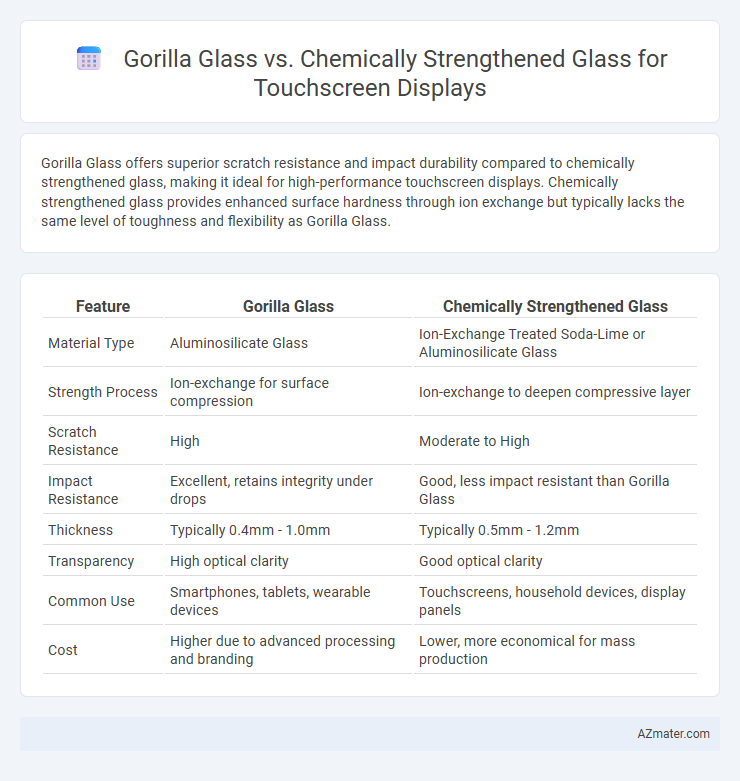Gorilla Glass offers superior scratch resistance and impact durability compared to chemically strengthened glass, making it ideal for high-performance touchscreen displays. Chemically strengthened glass provides enhanced surface hardness through ion exchange but typically lacks the same level of toughness and flexibility as Gorilla Glass.
Table of Comparison
| Feature | Gorilla Glass | Chemically Strengthened Glass |
|---|---|---|
| Material Type | Aluminosilicate Glass | Ion-Exchange Treated Soda-Lime or Aluminosilicate Glass |
| Strength Process | Ion-exchange for surface compression | Ion-exchange to deepen compressive layer |
| Scratch Resistance | High | Moderate to High |
| Impact Resistance | Excellent, retains integrity under drops | Good, less impact resistant than Gorilla Glass |
| Thickness | Typically 0.4mm - 1.0mm | Typically 0.5mm - 1.2mm |
| Transparency | High optical clarity | Good optical clarity |
| Common Use | Smartphones, tablets, wearable devices | Touchscreens, household devices, display panels |
| Cost | Higher due to advanced processing and branding | Lower, more economical for mass production |
Introduction: Gorilla Glass vs Chemically Strengthened Glass
Gorilla Glass is an aluminosilicate glass designed for enhanced scratch resistance and durability in touchscreen displays, widely used in smartphones and tablets. Chemically strengthened glass undergoes an ion-exchange process that increases surface compression, improving resistance to cracks and impact. Both materials aim to protect touchscreens but differ in manufacturing techniques and performance characteristics for damage resistance.
Composition and Manufacturing Processes
Gorilla Glass is made from an alkali-aluminosilicate sheet glass that undergoes an ion-exchange process, where smaller sodium ions in the glass near the surface are replaced by larger potassium ions to create a durable compression layer. Chemically strengthened glass, also based on aluminosilicate glass, employs a similar but customizable ion-exchange process, allowing for varying depths and strengths of the compressive layer tailored to specific applications. Both manufacturing methods focus on enhancing surface hardness and impact resistance, but Gorilla Glass is specifically engineered by Corning with proprietary formulations optimized for touchscreen durability and clarity.
Strength and Durability Comparison
Gorilla Glass utilizes an ion-exchange process to achieve high surface compression, making it exceptionally resistant to scratches and impacts, which enhances touchscreen durability. Chemically strengthened glass also undergoes ion-exchange but often offers a thicker compression layer, providing superior strength against bending and breakage in flexible displays. Comparative tests reveal Gorilla Glass excels in scratch resistance, while chemically strengthened glass typically offers greater toughness and longevity under repeated mechanical stress.
Scratch Resistance Performance
Gorilla Glass, made by Corning, offers superior scratch resistance due to its aluminosilicate composition and chemical strengthening process that enhances surface compressive stress. Chemically strengthened glass, while also treated to improve surface hardness through ion exchange methods, typically exhibits slightly lower scratch resistance compared to Gorilla Glass variants like Gorilla Glass Victus. In touchscreen displays, the high scratch resistance of Gorilla Glass ensures better durability against sharp objects and everyday abrasions, maintaining clarity and touch sensitivity over extended use.
Thickness and Weight Considerations
Gorilla Glass typically ranges from 0.4mm to 1mm in thickness, offering a lightweight yet durable solution for touchscreen displays, which helps maintain overall device slimness and portability. Chemically strengthened glass, while similar in thickness, can sometimes be produced thinner without compromising strength, potentially reducing weight further. Manufacturers often select Gorilla Glass for a balanced combination of thinness, weight, and scratch resistance, whereas chemically strengthened glass may be favored in designs prioritizing minimal weight and maximum toughness in ultra-thin formats.
Optical Clarity and Touch Sensitivity
Gorilla Glass offers superior optical clarity due to its high-quality aluminosilicate composition that minimizes light distortion and enhances screen brightness for touchscreen displays. Chemically strengthened glass, created through ion-exchange processes, provides excellent touch sensitivity by maintaining a smooth surface that accurately registers capacitive input without interference. Both materials ensure durability, but Gorilla Glass is often preferred in devices where enhanced optical performance and vivid display quality are critical.
Cost Implications for Manufacturers
Gorilla Glass offers advanced scratch and impact resistance, but its manufacturing process involves higher material and licensing costs compared to chemically strengthened glass. Chemically strengthened glass provides a more cost-effective solution with sufficient durability for many touchscreen applications, making it attractive for budget-conscious manufacturers. Balancing performance needs and production expenses, manufacturers often select chemically strengthened glass to optimize cost-efficiency without significantly compromising display quality.
Environmental Impact and Sustainability
Gorilla Glass uses an ion-exchange process that strengthens the glass surface while maintaining recyclability, contributing to lower environmental impact through extended device lifespan. Chemically strengthened glass also employs ion-exchange, but variations in production energy consumption and potential use of heavy metals can influence its sustainability profile. Both technologies aim to improve durability and reduce electronic waste, but Gorilla Glass's widespread adoption and emphasis on eco-friendly manufacturing practices position it as a more environmentally sustainable option.
Real-World Case Studies and Applications
Gorilla Glass, produced by Corning, is extensively used in smartphones such as the Samsung Galaxy series due to its high resistance to scratches and impact, backed by real-world drop tests. Chemically strengthened glass, commonly found in automotive touch displays, undergoes an ion-exchange process that enhances surface compressive stress, improving durability against thermal and mechanical shock. Case studies from consumer electronics show Gorilla Glass excels in thin, lightweight devices, while chemically strengthened glass is preferred in environments requiring higher thermal resistance and flexural strength.
Which Glass is Better for Touchscreen Displays?
Gorilla Glass offers superior scratch resistance and durability due to its chemically strengthened aluminosilicate composition, making it highly popular in touchscreen displays for smartphones and tablets. Chemically strengthened glass, while also enhanced through ion-exchange processes, may lack the same balance of thinness and impact resistance found in Gorilla Glass, potentially affecting touchscreen sensitivity and longevity. For high-performance touchscreen devices demanding optimal protection and responsiveness, Gorilla Glass generally provides a better combination of toughness, clarity, and tactile experience.

Infographic: Gorilla glass vs Chemically strengthened glass for Touchscreen display
 azmater.com
azmater.com